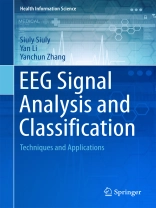This book presents advanced methodologies in two areas related to electroencephalogram (EEG) signals: detection of epileptic seizures and identification of mental states in brain computer interface (BCI) systems. The proposed methods enable the extraction of this vital information from EEG signals in order to accurately detect abnormalities revealed by the EEG. New methods will relieve the time-consuming and error-prone practices that are currently in use.
Common signal processing methodologies include wavelet transformation and Fourier transformation, but these methods are not capable of managing the size of EEG data.
Addressing the issue, this book examines new EEG signal analysis approaches with a combination of statistical techniques (e.g. random sampling, optimum allocation) and machine learning methods. The developed methods provide better results than the existing methods. The book also offers applications of the developedmethodologies that have been tested on several real-time benchmark databases.
This book concludes with thoughts on the future of the field and anticipated research challenges. It gives new direction to the field of analysis and classification of EEG signals through these more efficient methodologies. Researchers and experts will benefit from its suggested improvements to the current computer-aided based diagnostic systems for the precise analysis and management of EEG signals.
Зміст
Electroencephalogram (EEG) and its background.- Significance of EEG signals in medical and health research.- Objectives and structures of the book.- Random sampling in the detection of epileptic EEG signals.- A novel clustering technique for the detection of epileptic seizures.- A statistical framework for classifying epileptic seizure from multi-category EEG signals.- Injecting principal component analysis with the OA scheme in the epileptic EEG signal classification.- Cross-correlation aided logistic regression model for the identification of motor imagery EEG signals in BCI applications.- Modified CC-LR Algorithm for identification of MI based EEG signals.- Improving prospective performance in the MI recognition: LS-SVM with tuning hyper parameters.- Comparative study: Motor area EEG and All-channels EEG.- Optimum allocation aided Naive Bayes based learning process for the detection of MI tasks.- Summary discussions on the methods, future directions and conclusions.












